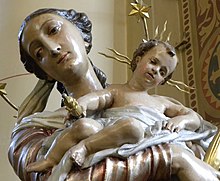Martin Falbesoner
Martin Falbesoner (born October 1, 1728 in Nassereith ; † October 19, 1815 there ) was an Austrian sculptor and sacristan .
Life
He was the second of nine children from the marriage of Johann Georg Falbesoner and his wife Maria (née Pacher). A plaque on the house where he was born next to the church (today Schulgasse 39) still reminds of this today. Nothing is known about his training as a sculptor; for the most part he was probably self-taught. Possible teachers could be Josef Anton Renn or Balthasar Jais from Imst. The bodies of his figures are usually slender and high, and often have tight-fitting robes.
On February 3, 1767 he married Rosina Neururer. Nine children were born from this marriage. His eldest son Josef Alois Falbesoner (1767–1848) succeeded him as a sculptor and sacristan. His grandson Ignaz Falbesoner (1808–1881) was also a sculptor and nativity scene carver. Martin Falbesoner's first dated work is the pulpit for the Karlskirche in Volders (1759/60). Most of his works were created between 1770 and 1790. Falbesoner was almost 50 years old at the time. In addition to his hometown Nassereith, he delivered works of art for places of worship in Ausserfern , on the Mieminger Plateau and in the Pitztal . Martin Falbesoner died on October 19, 1815 in Nassereith at the age of 87.
Works (selection)
- Breitenwang - parish church : lecture cross (1776), baptismal font cover (1776/79) and tabernacle (1779/82)
- Elmen - Widum: crucifix (late 18th century)
- Fiecht - Pankratius Chapel: St. Anna and Joachim (around 1780)
- Garmisch-Partenkirchen - Parish Church of St. Martin in Garmisch : 4 church fathers (around 1795)
- Hinterhornbach - parish church : 2 apostles at the high altar, tabernacle, putti and God the Father (around 1762/65)
- Imst - Josefbrunnen in the Schustergasse: St. Josef (around 1800)
- Lermoos - parish church : 12 figures of saints on the altars (around 1780)
- Lermoos - Nepomuk Chapel: St. Johannes Nepomuk (around 1780)
- Nassereith - parish church : Immaculata (1791), St. James the Elder and Christophorus (1790), church crib (around 1790)
- Obermieming - Nepomuk Fountain: St. Johannes Nepomuk (around 1790)
- Obsteig - parish church : 10 saints at the altars, group of guardian angels, pulpit with angels (around 1770/75)
- Plangeroß im Pitztal - Maria Hilf Church : St. Joseph and James at the high altar, angels, putti, crucifix (1771)
- Stanzach - Filial Church: St. Johannes, Josef and Sebastian (around 1777)
- Tannheim - Parish Church : Tabernacle (1786)
- Volders - Karlskirche : pulpit (1759/60)
literature
- Norbert Mantl: The Falbesoner from Nassereith - Martin Falbesoner. In: Tiroler Heimatblätter. Volume 26, 1951, Issues 7-9, pp. 78-85.
- Gert Ammann: The Tyrolean Oberland. The districts of Imst, Landeck and Reutte - his works of art, historical forms of life and settlement (= Austrian art monograph IX). Salzburg 1978.
- Richard Lipp: The church accounts as an art historical source using the example of the deanery parish church in Breitenwang. In: Tyrolean chronicler. Volume 49, 1992, pp. 28-36.
- Herbert Wittmann / Josef Mair: Thoughts on the history of furnishings and furnishings for the deanery parish church and the Church of the Resurrection in Breitenwang. In: Alt Füssen - yearbook of the historical association Alt Füssen. 2014, pp. 15-27.
- Klaus Wankmiller: Martin Falbesoner (1728-1815). For the 200th anniversary of the sculptor's death from Nassereith. In: Tiroler Heimatblätter. Volume 90, 2015, No. 2, pp. 75-79.
- Klaus Wankmiller: Martin Falbesoner (1728–1815) and his work. On the 200th anniversary of the death of the sculptor and sacristan from Nassereith. In: Extra Verren - Yearbook of the Museum Association of the Reutte District. Volume 10, 2015, pp. 97-164.
Individual evidence
- ↑ The memorial plaque accidentally says 1726 as the year of birth. In the baptismal register of the Nassereith community, October 1, 1728 is recorded as the birthday.
- ↑ Lipp (1992) shows from the church accounts that the tabernacle in Breitenwang comes from Falbesoner. Wittmann / Mair (2014) see a work by Peter Heel in the tabernacle that exists today.
| personal data | |
|---|---|
| SURNAME | Falbesoner, Martin |
| BRIEF DESCRIPTION | Austrian sculptor and sacristan |
| DATE OF BIRTH | October 1, 1728 |
| PLACE OF BIRTH | Nassereith |
| DATE OF DEATH | October 19, 1815 |
| Place of death | Nassereith |


